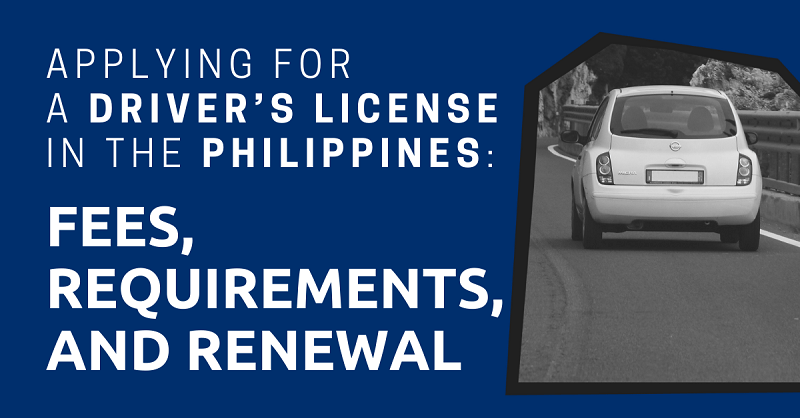
Private transportation is more convenient than taking public jeepneys, buses, and trains because these are often slow and crowded. For this reason, expats in the Philippines hire a car rental service with a chauffeur or drive a car instead.
Whether it’s a motorcycle or a car, driving a vehicle is a huge responsibility. You always need to keep yourself, your companions, and other motorists safe on the road. The first step to being able to drive on Philippine roads is to get a driver’s license.
Applying for a driver’s license in the Philippines can be a whole new, different experience. But as long as you are qualified, have your papers ready, and pass the written and practical exams, you should be able to get your driver’s license in less than a day.
All driver’s licenses are issued by the Land Transportation Office (LTO), a government agency under the Department of Transportation of the Philippine government.
This article will guide you through getting a driver’s license in the Philippines, the requirements and qualifications for getting one, and the fees you need to pay for the application.
This article will take approximately 21 minutes to read. Don't have the time right now? No worries. You can email the ad-free version of the article to yourself and read it later!
Disclaimer: This article may include links to products or services offered by ExpatDen’s partners, which give us commissions when you click on them. Although this may influence how they appear in the text, we only recommend solutions that we would use in your situation. Read more in our Advertising Disclosure.
Contents
- Uses of a Driver’s License
- Types of Driver’s License In The Philippines
- Fees
- Processing Time
- Converting An International/Foreign Driver’s License to a Philippine Driver’s License
- Motorcycle License
- ID Numbers
- International Driver’s License in the Philippines
- Renewal
- Expired Permits and Licenses
- Now, On To You
Uses of a Driver’s License
In the Philippines, a driver’s license is a permit that will allow you to legally drive a vehicle in the country. You can also use it as proof of identity when dealing with government agencies or business establishments. As an expat, these facts are essential to know, especially if you plan to stay in the Philippines for a very long time.
Types of Driver’s License In The Philippines
Compared to other countries, the Philippines has three different driver’s licenses, depending on the driver’s purpose and qualifications.
This article will discuss only the two types generally offered to expats: student permit and non-professional driver’s license. The last type, professional driver’s license, is reserved for those driving heavy operating machinery or driving for a living — both jobs not applicable for foreigners.
If you apply for a driver’s license for the first time, you need to start from level one of the application, which is a student permit. Then, you can move up to a non-professional driver’s license.
Depending on the license you need to acquire, the application process will be different. However, know that you need to take theoretical and practical tests as part of the application process.
Student Permit
Suppose you are a foreigner arriving in the Philippines and never had a driver’s license before in your home country. In that case, you need to obtain a student permit before applying for a non-professional driver’s license.
This permit is valid for one year from the date of release.
Qualifications
To apply for a student permit, you must be:
- At least 18 years of age and have stayed in the Philippines for at least one month, along with a visa duration for at least six months from the date of application.
- Able to speak and read English, Filipino, or any other regional languages such as Cebuano
- Physically and mentally fit
Starting August 3, 2020, anyone who wants to apply for an LTO student permit is required to take a 15-hour theoretical driving course (TDC) as part of an effort to ensure that the permit is issued to individuals who are capable to drive. You could either avail of this course at LTO-accredited driving schools or directly at the LTO office.
Requirements
You need to prepare the following documents for your application:
- A fully accomplished Application for Driver’s License (ADL) form which you can download from the LTO’s official website
- One original and a photocopy of your passport showing the entry date of at least one month and visa duration of at least six months from the application date
- If you were born in the Philippines, a photocopy of your birth certificate validated by the Philippine Statistics Authority. However, this is not necessary if you already have an original and photocopy of your passport with you.
- Medical examination certificate from an LTO-accredited hospital or clinic. The said clinic will submit a soft copy of your certificate to LTO and will provide you with a hard copy that you’ll need to present during your application.
- A certificate proving that you have finished the TDC mandated by LTO. Usually, the driving school will submit the certificate electronically to the LTO-IT system on behalf of their students. Your driving school will also give you a hard copy of the certificate for further verification. Take note that the LTO will deny your application if your driving school fails to submit the certificate electronically through their system.
- Additional requirements would include a marriage certificate for married women or a Taxpayer’s Identification Number or TIN if employed.
TDC
The tests needed to apply for a driver’s license in the Philippines will vary depending on the license you want to get. Each type of license requires different sets of courses and exams.
As stated previously, new LTO policies require applicants to take a theoretical driving course (TDC) from an accredited school before getting a student permit. This driving course needs to be completed within two years from its start date.
These lessons will be delivered through classroom sessions or remote learning and will cover fundamental topics, such as:
- Essential function and organization of the Land Transportation Office
- Traffic rules and regulations (including traffic signs and signals)
- Road crash risk reduction
- Parking techniques (parallel, reverse, angle parking, three-point turn, etc.)
- Fuel conservation
- Road courtesy, respect, and discipline
- Defensive driving
Written Exam
After taking their theoretical driving course, you will need to take an English, Filipino, or other regional languages exam before getting a student permit or a non-professional driver’s license.
The written exam, called the Basic Driving Theory test, consists of about 40 items. And you will need to get 30 correct answers or above to pass the exam.
Digitized Written Exam
More recently, LTO unveiled a newer, more digitized version of the written exam with 60 items, and you will need to get at least 48 correct answers to pass. Whether you will take the digitized version or not will depend on the LTO district office where you will send your application. The digitized exam will consist of the following categories:
- General driving knowledge
- Handling and driving
- Parking
- Road signs and lane markings
- Road position
- Driving emergencies
- Violations and penalties
When you pass the TDC, you will be issued a Theoretical Driving Course (TDC) certificate which you will use when applying for a student permit.
Application Process
Here is a rundown of the steps you need to follow in applying for a student permit in the Philippines.
- Proceed to an LTO office. As per LTO, foreign applicants need to go to LTO’s Central Office in Quezon City for their application.
- Go to the Customer Service Counter to request an Application for Driver’s License (ADL) form and a requirements checklist. You can also download a copy of the ADL form from the LTO’s website and fill it out before your application.
- Along with the form, you’ll receive a queue number. Fill out the application form and submit the necessary documents once called. They will then receive your documents to check for authenticity and completeness.
- They will take your photo and biometrics.
- An approving office will further review your requirements and qualifications.
- Once the approving officer approves your application, you can go to the cashier and pay the necessary fees.
- Finally, the releasing clerk will give your Student Permit in the form of an official receipt. Once you receive your Student Permit, you can write your name and signature on the log sheet.
Non-Professional Driver’s License
A non-professional driver’s license will allow you to operate a private vehicle of up to 4,500 GVW (Gross Vehicle Weight). This license is applicable for both manual and automatic transmissions of specific car models such as sedans, pickups, minivans, standard utility vehicles or SUVs, and other passenger vehicles.
Student permit holders will also need to wait for at least 31 days from the date of release before they could apply for a non-professional driver’s license.
The validity of non-professional driver’s licenses is five years. However, the LTO recently started issuing driver’s licenses with a 10-year validity especially to law-abiding motorists with no violations or records.
Qualifications
Once you can secure a student permit from the LTO, you are now eligible to get a non-professional driver’s license.
The qualifications for applying for a non-professional driver’s license are similar to those of the student permit.
However, the main difference is that you will need to complete a minimum of eight hours of practical driving course (PDC) provided by an LTO-certified and TESA-certified driving school. But for those who cannot afford driving lessons from a private driving school, the LTO also offers the same classes at a lower fee.
Requirements
Prepare the following documents for the application:
- A filled out Application for Driver’s License (ADL) form that you can download from the LTO website.
- Original copy of your Student Permit issued at least 31 days from the date of application.
- A medical examination certificate from an LTO-accredited clinic. If applying for a non-professional driver’s license, you may use the same certificate that you used to apply for the student permit as long as it is not more than two months from the issue date.
- A Practical Driving Course (PDC) certificate. The driving school needs to submit your PDC certificate electronically to the agency’s LTO-IT system.
- Additional requirements include a Taxpayer’s Identification Number if employed.
PDC
Non-professional driver’s license applicants also need to take a practical driving course (PDC). This course is eight hours long, and involves hands-on driving instructions teaching essential topics such as start and stop, parking, road crossing, light traffic, and many others.
Written Exam
If you apply for the non-professional driver’s license, you will also take another written exam, with a different set of questions specific to non-professional drivers.
Practical Driving Exam
Once you have passed the written exam, you need to take a practical driving exam, which lasts about five minutes or less.
Student permits are required for you to be able to take the practical driving exam.
In this exam, you only need to drive through a one-kilometer-long obstacle course in one round: a flat and elevated road, making turns, and parking. Your instructor will evaluate your driving skills using a demerit system. In this system, you will start with 100 points, and the instructor will deduct a few points for every mistake you make during the exam. You need to obtain 70 points or higher to pass this exam.
There are three criteria in the practical driving test you will need to keep in mind. Each criterion consists of the following topics:
- Pre-driving check-up (10 points)
- Checking tires and batteries
- Checking/cleaning/adjusting mirrors, light, and windshield wiper
- Use of seatbelt or helmet
- Checking hand and foot brake
- Disengaging clutch when starting the engine (for applicants of driver’s license with restriction codes B up until C1, which allows them to operate vehicles with manual and automatic transmission)
- Driving skills (50 points)
- Steering
- Engine control
- Use of brakes
- Speed control
- Turning
- Backing
- Parking
- Observance of traffic rules (40 points)
- Right of way to other vehicles
- Stoplights, signals, and other signs
- Right of way for other vehicles, pedestrians, cyclists, etc.
When you pass the PDC, you will be issued a Practical Driving Course (PDC) certificate which you will use when applying for a non-professional driver’s license.
Application Process
Most of the steps for applying for a non-professional driver’s license are similar to the process of applying for a student permit.
Just like when applying for a student permit, you need to have your photo and biometrics taken. Finally, sign a release form after you receive the non-professional driver’s license.
Fees
The fees you’ll pay for your driver’s license application will depend on the type of driver’s license you are applying for. There are many other expenses you will need to consider. So be sure to prepare a significant amount of cash when applying for a driver’s license in the Philippines.
| Fee Type | Student Permit | Non-Professional Driver’s License |
| Theoretical driving course | Free at the LTO or up to ₱4,500 ($90) depending on any LTO-accredited school (with an average of around ₱1,500 or $30) | N/A |
| Practical driving course | N/A | This will make up a vast bulk of your expenses. It varies from ₱3,500 ($70+) to ₱10,000 ($200+), depending on the school and type of PDC you will take. In some regions, LTO has Driver’s Education Centers to get a PDC at a low price. |
| Student permit fee | ₱317.63 ($6.28) | N/A |
| Non-professional driver’s license fee | N/A | ₱585 ($11.57) |
| Application fee | ₱100 or $2 | ₱100 or $2 |
| Computer fee | ₱67.63 or $1.35 | ₱67.63 or $1.35 |
| Medical examination certificate | ₱450 to ₱500 or $9 to $10 depending on the clinic. | Can use the previous certificate as long as not more than 2 months from the issue date |
| Written exam fee | ₱167.63 or $3.36 | ₱167.63 or $3.36 |
| Car rental fee for the practical exam | N/A | ₱250 or $5. But if you have your vehicle, you can use it for this test. |
| TOTAL | Around ₱2,600 or $52 | Around ₱4,600 or $92 |
Processing Time
Most LTO offices, especially in the National Capital Region, are open from 8 AM to 5 PM. A large part of your day will be spent sitting and waiting for the release of your documents and taking the written or practical exam.
The best time to come to the LTO office is around 7 AM to avoid long lines and also be able to finish everything in one day. It is also recommended to apply for a driver’s license on non-peak days Tuesdays to Thursdays. The LTO also recommends applicants use the LTMS portal for faster processing.
Converting An International/Foreign Driver’s License to a Philippine Driver’s License
If you already have a valid foreign driver’s license with you, you can use it within 90 days from the date of your arrival. However, if the driver’s license is not in English, you need to get an official English translation of your foreign driver’s license from your country’s embassy.
If you plan to stay in the country for more than 90 days or if you have an expired driver’s license, you should convert the foreign license to a local one. To do so, you must be:
- 18 years old or above
- Able to speak and write in English or Filipino
- Physically and mentally fit to operate a motor vehicle
- Residing in the Philippines for at least one month and plans to stay in the Philippines within one year from the date of application
To convert your foreign driver’s license, you need:
- A completed Application for Driver’s License (ADL) form
- An original and photocopy of your passport showing the entry date of at least one month and visa duration of at least one year from the application date
- One original and one photocopy of your driver’s license.
- Medical examination certificate from an LTO-certified clinic
Head to the nearest LTO office and follow these steps:
- Get a queue number from the Customer Service Counter and ask for an ADL form and requirements checklist. Alternatively, you can also download the form and fill it out before applying.
- Submit your documents and the personnel will then check your records to see if they are complete and authentic.
- Next, your picture and biometrics will be taken.
- Proceed to the cashier and pay the application fee.
- If your foreign or international driver’s license is still valid, you don’t need to take a written and practical exam. But if it is already expired, you would need to take the Basic Driving Theory Test for a non-professional license. Once you pass the written exam, you will then proceed to the practical exam.
- After passing the written and practical exams (or if your foreign/international driver’s license is still valid), you may head to the cashier, pay the remaining fees, and get the Official Receipt.
- Proceed to the Releasing Counter after getting the Official Receipt and present it to the receiving personnel to get your license.
- Finally, write your name and signature in the Release Form.
Fees are at ₱852.63 ($17.14) to ₱920.26 ($18.50), depending on whether you took the written and practical driving exams as part of your application.
Motorcycle License
The qualifications, needed documents, and process for getting a driver’s license for motorcycles are the same as that for a car.
However, when you apply for a driver’s license for your motorcycle, you will need to indicate in your Application for Driver’s License (ADL) form that you intend to apply for a motorcycle.
You will also need to show that you are capable of operating a motorcycle through a written and practical driving test. In the case of a practical driving test, you will either need to bring your motorcycle or rent one for ₱150 ($3).
ID Numbers
Driver’s licenses in the Philippines contain restriction codes, which dictate what type of vehicles you can operate. If you were apprehended using a vehicle you are not allowed to drive, you can face penalties and litigation. Therefore, it is important to check what type of vehicles you can operate through your driver’s license’s restriction codes.
Recently, the LTO unveiled a new restriction code scheme that is more clear and specific to the type of vehicle license holders are allowed to operate. This restriction code scheme is composed of a driver’s license code shown in a combination of letters and numbers (e.g. A, A1, B, B1) which explains the type of vehicle a driver’s license holder is allowed to drive (e.g. motorcycle, sedan, van, etc,). These codes are then followed by a set of subcategories also shown in a combination of letters and numbers (e.g. L1, M2, O3).
International Driver’s License in the Philippines
Getting an International Driver’s License is possible in the Philippines. However, instead of going to the Land Transportation Office, you need to apply for it at the Automobile Association of the Philippines (AAP) — the country’s biggest automobile club.
An International Driver’s License is valid for one year from the date of issue. To apply for an international driver’s license, you need the following documents:
- Original and photocopy of your professional or non-professional driver’s license (needs to be valid for at least one year)
- Two pieces of 2 x 2 colored ID photo in white background
- Original copy of passport
- Photocopy of passport
- Alien Certificate Registration (for permanent residents)
To apply for an international driver’s license, head to the nearest AAP office in your area and submit the necessary documents. Here are the places where you can find an AAP office:
- Alabang
- Makati
- Quezon City
- Batangas
- Pampanga
- Cebu
- Davao
Note that processing times would vary from one AAP office to another, with some needing four to five business days to process your international driver’s license and others requiring two to three business days. The fees include:
- Joining fee: ₱300 ($6A)
- AP Annual Registration fee: ₱1,200 ($24)
- Philippine International Driving Permit processing fee: ₱300 ($6)
Renewal
Renewing a driver’s license in the Philippines will depend on how long your license has been expired as well as the type of license you wish to renew. These two factors will determine the qualifications and documents you need to present, the total amount of fees you need to pay, and even whether you will be allowed to renew your license or not.
For instance, if your driver’s license has expired for ten years or more, you are no longer allowed to apply for renewal and you have to start from scratch again.
Qualifications and Requirements for Renewal
As of October 28, 2021, the LTO has required all applicants who wish to renew their driver’s license to complete a Comprehensive Driver’s Education (CDE) course and pass its corresponding exam to be eligible for renewal. This is a refresher course that seeks to reorient drivers on basic traffic rules and regulations as well as road safety.
The materials for this course can be obtained for free at all LTO offices, LTO social media pages, and the LTO website. You can take this course along with the corresponding exam at an LTO-accredited school. Alternatively, you can also take the exam through the agency’s online Land Transportation Management System (LTMS) portal or in select LTO offices.
When it comes to the documents for driver’s license renewal, some of them are similar to those needed when applying for a new driver’s license (non-professional), such as a medical certificate and the Application for Driver’s License (ADL) form. Other than these requirements, here are the other documents you need to renew your driver’s license:
- Original copy of driver’s license that’s due to expire
- A certificate proving that you completed the Comprehensive Driver’s Education (CDE) course and its corresponding exam.
Process
The process for renewing a driver’s license is shorter than applying for a new one:
- The LTO encourages applicants to use the LTMS online portal to renew licenses.
- Head to the nearest LTO office, licensing center, or renewal office at select malls. Submit all the necessary documents to the receiving personnel.
- Once they confirm your documents are valid and complete, they will then show you your license details to see if there are changes needed to be made.
- Pay the necessary fees.
- Have your biometrics and photo taken.
- Finally, your new driver’s license will be released along with the old one and an official receipt. You will also need to affix your name and signature in the release form.
Fees
Fees for renewing a driver’s license in the Philippines would include:
- Computer fee: ₱67.63 ($1.35)
- Application fee: ₱100 ($2)
- CDE fee: ₱1,000 ($20)
- If expired, a penalty fee as high as ₱225 ($4.45)
Expired Permits and Licenses
Once your driver’s license has expired for more than two years but less than nine years (dormant), you will need to retake and pass the theoretical and practical exams and pay additional fees.
Meanwhile, an expired student permit cannot be renewed or extended and it cannot be used to apply for a non-professional driver’s license.
Now, On To You
The information obtained for this article is valid as of October 2021. The requirements and qualifications for getting a driver’s license in the Philippines could change without prior notice.
For more information, it’s best to check the official website of the Land Transportation Office in the Philippines and the Automobile Association of the Philippines if you wish to get an international driver’s license.
Getting a driver’s license in the Philippines can be complicated, even for Filipinos. And that is due to the driver’s licenses in the country that varies depending on the purpose. But because of the current situation with the country’s public transportation, many Filipinos and foreigners would opt to take the long lines in getting a driver’s license. In doing so, it is best to dress well (no slippers, shorts, or undershirts) while at the LTO office. Also, never use fixers and follow the application process properly to get your driver’s license.







